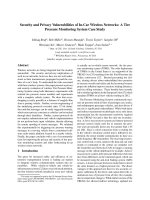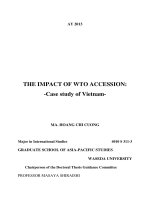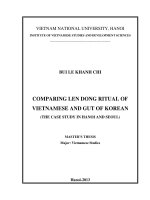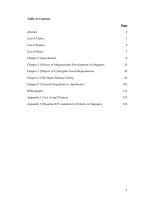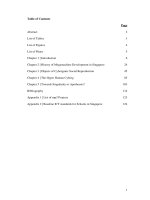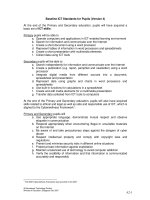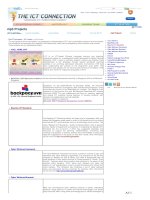design project of transmission system case study 10 plan 1
Bạn đang xem bản rút gọn của tài liệu. Xem và tải ngay bản đầy đủ của tài liệu tại đây (929.56 KB, 45 trang )
<span class="text_page_counter">Trang 1</span><div class="page_container" data-page="1">
<b>HO CHI MINH UNIVERSITY OF TECHNOLOGYVIETNAM NATIONAL UNIVERSITY</b>
<b>FALCUTY OF MECHANICALENGINEERING DEPARTMENT OF</b>
HO CHI MINH CITY, October 4 2021<small>th</small>
</div><span class="text_page_counter">Trang 2</span><div class="page_container" data-page="2"><i><small>Mechanical Faculty, Ho Chi Minh city University of Technology</small></i>
Nowadays, the development of technology has received growing interest bygovernments from many countries. With the help of technology, we can easily increaseour productivity and create more safe conditions in workplaces. To reach theseaccomplishments, it takes us a lot of time to practice, do research and improve ourtechnological skills from the beginning of our university life.
Design project of transmission system is a helpful subject which allows mechanicalengineering students to apply some theoretical knowledge from the previous subjectmachine elements. It also helps students to get familiar with calculating each elementfor a realistic mechanical design.
Thanks to <b>Dr Nguyen Tan Tien</b>, with his instruction, I could totally complete thisproject. During the period of doing this project, I could reinforce all knowledge,approach and learn how to use some engineering softwares such as Autocad,Solidworks, etc. Also, I was able to learn to accomplish the mindset of an engineerwhich plays a pivotal role in my future career.
I have tried my best to perform this project. However, due to limited time and mylack of practical experience, there still are some minor errors in this report. Therefore, Ilook forward to receiving suggestions in order to enrich my knowledge.
</div><span class="text_page_counter">Trang 3</span><div class="page_container" data-page="3">4. Technical specification table...4
CALCULATION AND DESIGN OF MACHINE ELEMENTS...5
I. Calculation and design of -belt transmission system...5𝑉1. Select belt and belt diameter 2...5
2. Define preliminary center distance...5
3. Define belt length and center distance...6
4. Calculating the number of belts...7
5. Define main dimension of pulley...7
</div><span class="text_page_counter">Trang 4</span><div class="page_container" data-page="4"><i><small>Mechanical Faculty, Ho Chi Minh city University of Technology</small></i>
3. Define pitch diameter...12
4. Analyze contact stress...14
5. Analyze bending stress...15
6. Analyze overload stress...16
7. Force calculating...17
8. Summary...17
III. Design elastic coupling...18
1. Choose dimension...18
2. Force apply on the coupling...18
ANALYZING LUBRICATION CONDITION OF THE SYSTEM...19
I. Lubrication condition of the system:...19
II. Summary...19
CALCULATION AND DESIGN OF SHAFT AND KEY...20
I. Choose shaft material:...20
II. Calculate and design shaft 𝐼...21
1. Calculate forces distribute on shaft 𝐼...21
2. Force and momentum analysis on shaft 𝐼...22
3. Sections diameter and keys selection:...24
III. Calculate and design shaft 𝐼𝐼...25
1. Calculate forces distribute on shaft 𝐼𝐼...25
2. Force and momentum analysis on shaft 𝐼𝐼...25
3. Sections diameter and keys selection:...28
IV. Shafts and keys test...29
1. Test for shafts...29
2. Test for keys...31
CALCULATION AND TEST BEARINGs...32
I. Calculation and select bearing for shaft 𝐼...32
1. Calculation dynamic loading...32
</div><span class="text_page_counter">Trang 5</span><div class="page_container" data-page="5">2. Calculation static loading...33
II. Calculation and select bearing for shaft 𝐼𝐼...33
1. Calculation dynamic loading...34
2. Calculation static loading...35
DESIGN GEAR BOX COVER AND RELATIVE ELEMENT SELECTION... 36
I. Calculate gear box dimensions...36
II. Calculation relative elements...37
6. Oil level stick...40
7. Oil seal and oil barrier...40
Tolerance and kind of assembly selection...42
I. Tolerance of key and keyway...42
II. Tolerance assembly of the gears...42
III. Tolerance assembly of bearings...42
IV. Tolerance assembly of oil seal...43
V. Tolerance assembly of caps of hub...43
REFERENCES...44
</div><span class="text_page_counter">Trang 6</span><div class="page_container" data-page="6"><i><small>Mechanical Faculty, Ho Chi Minh city University of Technology</small></i>
<b>INDEX OF IMAGES AND DIAGRAMS</b>
Figure 1. 1: Position of each shaft diagram 2
Figure 2. 1: Classical 𝑉-belt...5
Figure 4. 1: Shafts rotational direction diagram...20
Figure 4. 2: Force equilibrium diagram on 2 shafts...21
Figure 4. 3: Force distribution diagram on shaft 𝐼...22
Figure 4. 4: Free body diagram and shaft structure of shaft 𝐼...23
Figure 4. 5: Drawing of shaft 𝐼...25
Figure 4. 6: Force distribution diagram on shaft 𝐼𝐼...26
Figure 4. 7: Free body diagram and shaft structure of shaft 𝐼𝐼...27
Figure 4. 8: Drawing of shaft 𝐼𝐼...29
Figure 6. 1: Eyebolt...37
Figure 6. 2: Taper pin...38
Figure 6. 3: Oil plug...38
Figure 6. 4: Visitor door...39
Figure 6. 5: Vent button...39
Figure 6. 6: Oil level stick...40
Figure 6. 7: Oil barrier...40
Figure 6. 8: Oil seal...41
</div><span class="text_page_counter">Trang 7</span><div class="page_container" data-page="7"><b>INDEX OF TABLES</b>
Table 1. 1: Designing...1
Table 1. 2: Efficiency of each transmission parts...1
Table 1. 3: Motor information...2
Table 1. 4: Power calculating...3
Table 1. 5: Rated speed calculating...3
Table 1. 6: Torque calculating...3
Table 1. 7: The overall parameters of the shafts...4
Table 2. 1: Input data of 𝑉-belt system...5
Table 2. 2: The overall parameters of -belt type 𝑉 𝐴...5
Table 2. 3: The parameters of -belt pulley type 𝑉 𝐴...7
Table 2. 4: Summary specification of the 𝑉-belt transmission...9
Table 2. 5: Input data of bevel gear system...10
Table 2. 6: Summary specification of the bevel gear transmission...17
Table 2. 7: Input data of elastic coupling...18
Table 2. 8: Dimensions of elastic coupling...18
Table 2. 9: Dimensions of the pin...18
Table 4. 1: Summary specification of the oil lubrication...19
Table 4. 2: Shaft material mechanical properties...20
Table 4. 3: Force magnitude distribute on shaft 𝐼...22
Table 4. 4: Key statistic on shaft 𝐼...24
Table 4. 5: Force magnitude distribute on shaft 𝐼𝐼...25
Table 4. 6: Key statistic on shaft 𝐼𝐼...28
Table 4. 7: Shaft test at dangerous sections...30
Table 4. 8: Key statistic on both shafts...31
Table 4. 9: Key test for all cross sections...31
Table 5. 1: Forces apply on shaft 𝐼...32
Table 5. 2: Bearing size preliminarily selection for shaft 𝐼...32
</div><span class="text_page_counter">Trang 8</span><div class="page_container" data-page="8"><i><small>Mechanical Faculty, Ho Chi Minh city University of Technology</small></i>
Table 5. 3: Forces apply on shaft 𝐼𝐼...34
Table 5. 4: Bearing size preliminarily selection for shaft 𝐼𝐼...34
Table 6. 1: Eyebolt dimension...37
Table 6. 2: Lock pin dimension...38
Table 6. 3: Oil plug dimension...38
Table 6. 4: Visitor door dimension...39
Table 6. 5: Vent button dimension...40
Table 6. 6: Oil seal dimension...41
Table 7. 1: Tolerance of key and keyway...42
Table 7. 2: Tolerance assembly of the gears...42
</div><span class="text_page_counter">Trang 9</span><div class="page_container" data-page="9"><b>1. Efficiency of whole system</b>
Based on table 2.3 [1], we preliminarily select the efficiency of each transmission parts.
<b>Table 1. 2: Efficiency of each transmission parts</b>
Transmission parts Efficiency factor
Flexible coupling, 𝜂<small>𝑐</small> 0.98Roller bearing, 𝜂<small>𝑟𝑏</small> 0.99
Therefore, we can determine the efficiency of transmission system based on equation2.9 [1]:
<b>3. Distribute transmission ratio</b>
Equation 2.15 [1] is used to determine the total ratio:𝑢<small>𝑡 </small>= 𝑢<sub>𝑏 </sub>× 𝑢<sub>𝑏𝑔 </sub>= 4 × 2.5 = 10.Where: 𝑢<small>𝑏 </small>= 4 velocity ratio of -belt; (table 2.4 [1]).𝑉
𝑢<small>𝑏𝑔 </small>= 2.5 velocity ratio of bevel gearbox.
From equation 2.18 [1], the number of preliminary revolutions can be determined as follow:
𝑛<small>𝑝 </small>= 𝑛<small>𝑙𝑣 </small>× 𝑢<small>𝑡 </small>= 160 × 10 = 1600 𝑟𝑝𝑚.
We choose number of synchronous revolutions of motor 𝑛<small>𝑠 </small>= 1500 𝑟𝑝𝑚.
<b>4. Select motor</b>
</div><span class="text_page_counter">Trang 10</span><div class="page_container" data-page="10">Motor Shaft
Shaft 𝐼Shaft 𝐼𝐼
Working Shaft
<i><small>Mechanical Faculty, Ho Chi Minh city University of Technology</small></i>
2We choose a motor that satisfy the conditions 2.19 [1]:
{<sup>𝑃</sup><small>𝑁 </small>≥ 𝑃<small>𝑛</small>𝑛<small>𝑁 </small>≅ 𝑛<small>𝑠</small>
We choose motor 𝑆𝑔 100 − 4𝐿 𝐵, followed by [2]. The motor has rated output power𝑃<small>𝑁 </small>= 3 𝑘𝑊 and rated speed 𝑛<small>𝑁 </small>= 1415 𝑟𝑝𝑚.
<b>Table 1. 3: Motor information</b>
Type 𝑃 𝑘𝑊, 𝑛, 𝑟𝑝𝑚 <sup>𝑇</sup><small>𝐿</small>𝑇<small>𝑁</small>
𝑇<small>𝑁</small> 𝐽, 𝑘𝑔𝑚<small>2</small> 𝑚 𝑘𝑔,𝑆𝑔 100𝐿 − 4𝐵 3 1415 2.6 2.7 0.0065 26
After selecting the motor, we recalculate the transmission ratio:⎛ <sup>𝑢</sup><sup>𝑏𝑔 </sup>= 2.5
𝑢<small>𝑡</small>⎨ =<sup>𝑛</sup><sup>𝑁</sup>
𝑛<small>𝑙𝑣</small>1415= <sub>8.84 ; 160</sub>= { 𝑢<small>𝑡 </small>= 𝑢<small>𝑏 </small>× 𝑢<small>𝑏𝑔</small>
𝑢<small>𝑡</small>⇒ 𝑢<small>𝑏 </small>=
<small>𝑏𝑔</small>8.84= = 3.54.
It is satisfy the range of transmission ratio for V-belt from table 2.4 [1].
<b>II. Technical specification</b>
<b>Figure 1. 1: Position of each shaft diagram</b>
𝑢
</div><span class="text_page_counter">Trang 11</span><div class="page_container" data-page="11">After we preliminary determine the efficiency of each transmission parts, power of themotor and ratio transmission of system, we have enough data to figure out power, ratedspeed of each shaft and to create a Technical Specification Table.
<b>1. Power</b>
<b>Table 1. 4: Power calculating</b>
Power transmitted on
𝑘𝑊Power transmitted on
Shaft 𝐼 <sup>𝑃</sup><small>𝐼</small> 𝑃<small>𝐼 </small>= 𝑃<small>𝑁 </small>× 𝜂<small>𝑏 </small>× 𝜂<small>𝑟𝑏</small>𝑃<small>𝐼 </small>= 3 × 0.96 × 0.99 = 2.85Power transmitted on
𝑃<small>𝐼𝐼 </small>= 𝑃<small>𝐼 </small>× 𝜂<small>𝑏𝑔 </small>× 𝜂<small>𝑟𝑏</small>𝑃<small>𝐼𝐼 </small>= 2.85 × 0.96 × 0.99 = 2.71Power transmitted on
Working Shaft <sup>𝑃</sup><small>𝑊𝑆.</small>
𝑃<sub>𝑊𝑆 </sub><sub>.</sub> = 𝑃<sub>𝐼𝐼 </sub>× 𝜂<sub>𝑐 </sub>× 𝜂<small>𝑟𝑏</small>𝑃<small>𝑊𝑆 .</small> = 2.85 × 0.98 × 0.99 = 2.6
<b>2. Rated speed</b>
<b>Table 1. 5: Rated speed calculating</b>
Rated Speed on Motor
𝑟𝑝𝑚Rated speed on Shaft 𝐼
𝑛<small>𝑁</small> 1415𝑛<small>𝐼 </small>=
𝑢 = = 4003.54 <small>𝑏</small>Rated speed on Shaft 𝐼𝐼
𝑛<small>𝐼</small> 400𝑛<small>𝐼𝐼 </small>=
𝑢 = = 1602.5 <small>𝑏𝑔</small>Rated speed on Working
𝑛<small>𝐼𝐼</small> 160𝑛<small>𝑊𝑆 .</small> =
𝑢 =1 <sup>= 160</sup><small>𝑐</small>
<b>3. Torque</b>
<b>Table 1. 6: Torque calculating</b>
Torque transmittedon Motor Shaft <sub>𝑇</sub>
𝑇 = 9.55 × 10 × <small>6𝑃</small><sub>𝑁</sub>
<small>𝑁</small>3𝑇<small>𝑁 </small>= 9.55 × 10 ×<small>6</small> = 20247.35
𝑁𝑚𝑚Torque transmitted
on Shaft I
𝑃<small>𝐼</small>𝑇<small>𝐼 </small>= 9.55 × 10 ×<small>6</small>
𝑛<small>𝐼</small>2.85𝑇<small>𝐼 </small>= 9.55 × 10 <small>6</small> × = 68072.4<sub>400</sub>
</div><span class="text_page_counter">Trang 12</span><div class="page_container" data-page="12"><i><small>Mechanical Faculty, Ho Chi Minh city University of Technology</small></i>
4Torque transmitted
on Shaft II
𝑃<small>𝐼𝐼</small>𝑇<small>𝐼𝐼 </small>= 9.55 × 10 ×<small>6</small>
𝑛<sub>𝐼𝐼</sub>2.71𝑇<small>𝐼𝐼 </small>= 9.55 × 10 <small>6</small> × = 161740.02 <sub>160</sub>Torque transmitted
on Working Shaft
𝑃<small>𝑊𝑆.</small>𝑇<small>𝑊𝑆 .</small> = 9.55 × 10<small>6</small> ×
𝑛<sub>𝑊𝑆</sub><sub>.</sub>2.6𝑇<small>𝐼𝐼𝐼 </small>= 9.55 × 10 <small>6</small> × = 156920.17 <sub>160</sub>
<b>4. Technical specification table</b>
<b>Table 1. 7: The overall parameters of the shafts</b>
Motor shaft Shaft 𝐼 Shaft 𝐼𝐼 WorkingShaft
Rated speed , 𝑛 𝑟𝑝𝑚 1415 400 160 160Torque , 𝑇 𝑁𝑚𝑚 20247.35 68072.4 161740.0
</div><span class="text_page_counter">Trang 13</span><div class="page_container" data-page="13"><b>CALCULATION AND DESIGN OF MACHINE ELEMENTS</b>
<b>I. Calculation and design of -belt transmission system</b>𝑽
<b>1. Select belt and belt diameter 2</b>
From the table 1.8, we summary the input data of the belt transmission.
<b>Table 2. 1: Input data of -belt system</b>𝑽
Rated speed , 𝑛 𝑟𝑝𝑚 1415Torque , 𝑇 𝑁𝑚𝑚 20247.35
Based on figure 4.1 and table 4.13 [1], we choose -belt type 𝑉 𝐴 with the following parameters:
<b>Figure 2. 1: Classical -belt </b>𝑽
<b>Table 2. 2: The overall parameters of -belt type </b>𝑽 𝑨
Type belt <sup>Cross-sectional dimensions, 𝑚𝑚</sup> <sup>Sectional area</sup><sub>𝐴, 𝑚𝑚</sub><small>2</small> Weight𝑞<small>𝑚</small>, /𝑘𝑔𝑚
<b>2. Define preliminary center distance</b>
Based on the standard diameter of pulley, we choose 𝑑<small>1</small> = 112 𝑚𝑚. Belt velocity:
𝑣 = 𝜋𝑑 𝑛<small>1 1</small> =60000
𝜋 × 112 ×141560000
<sup>𝐻 </sup> 𝑦<sup>0</sup>
</div><span class="text_page_counter">Trang 14</span><div class="page_container" data-page="14"><i><small>Mechanical Faculty, Ho Chi Minh city University of Technology</small></i>
30𝑙<small>13 </small>= 75 + 5 + 5 + 35 + 0.5 × 17 − 38 × cos 21.8° = ( )
110.86 𝑚𝑚.
With: 𝑘<small>1</small> = 5 𝑚𝑚follow table 10.3 [1];𝑘<small>2</small> = 5 𝑚𝑚 follow table 10.3 [1];
</div><span class="text_page_counter">Trang 15</span><div class="page_container" data-page="15">𝑌𝑂𝑋 <sup>𝑍</sup>𝐹
𝑙<small>𝑚13</small> = (1.2 ÷ 1.4)𝑑<small>𝐼 </small>= (1.2 ữ 1.4) ì 28 = (33.6 ữ 39.2) 𝑚𝑚 by formula10.10 [1]
We choose 𝑙<small>𝑚13</small>= 35 𝑚𝑚. Then we choose 𝑙<small>13 </small>= 111 𝑚𝑚.
<b>2. Force and momentum analysis on shaft :</b>𝑰
<b>Table 4. 3: Force magnitude distribute on shaft </b>𝑰
Magnitude 631.23 1867.88 252.49 634.54Therefore, we get the force distribution diagram as below:
<b>Figure 4. 3: Force distribution diagram on shaft </b>𝑰Reaction force at pins:
As figure 3.3, we have total force and momentum equations on shaft , yOz plane:𝐼∑ 𝐹<small>𝑦 </small>= 𝐹<small>𝑟 1</small>− 𝐹<small>𝐵𝑦 </small>− 𝐹<small>𝐶𝑦 </small>+ 𝐹<small>𝑟 2</small>= 0
∑𝑀<small>𝑥</small>⁄𝐵 = 𝐹<sub>𝑟</sub><sub>1</sub>𝑙<small>12 </small>+ 𝐹<small>𝐶𝑦</small>𝑙<small>11 </small>+𝐹<small>𝑎2</small>𝐹<small>𝐵𝑦 </small>= 885.72 𝑁
2 <sup>− 𝐹</sup><sup>𝑟</sup><sup>2</sup><sup>𝑙</sup><sup>13 </sup><sup>= 0</sup>⇔ {
<small>𝐶𝑦</small>= 380.04 𝑁
Where: 𝑑<small>𝑚 1</small>= 72.89 𝑚𝑚 is the mean cone diameter of bevel gear.
As figure 3.3, we have total force and momentum equations on shaft , xOz plane:𝐼{ <sup>∑ 𝐹</sup><small>𝑥 </small>= 𝐹<small>𝐵𝑥</small>− 𝐹<small>𝐶𝑥</small>+ 𝐹<small>𝑡 2</small>=
∑𝑀<sub>𝑦</sub>⁄𝐵 𝐹 = <sub>𝐶𝑥 </sub>𝑙<small>11 </small>− 𝐹<sub>𝑡</sub><sub>2</sub>𝑙<small>13 </small>=0
⇔ { <sup>𝐹</sup><sup>𝐵𝑥 </sup>= 896.58 𝑁𝐹<small>𝐶𝑥 </small>= 2764.46 𝑁
Therefore, we get momentum on yOz, xOz plane and torque diagram on shaft as 𝐼 below:
→<small>𝐶𝑦</small>𝐹→<small>𝑡2</small>𝑙<small>12</small> 𝑙<small>11</small>
</div><span class="text_page_counter">Trang 16</span><div class="page_container" data-page="16"><small>𝐶𝑥</small>𝐹→<sub>𝑡 2</sub>
𝐹→<small>𝑟 2</small>
𝐹→<sub>𝐵 𝑥</sub>𝐹→<small>𝐵𝑦</small>
𝐹→<small>𝐶 𝑦</small> →<small>𝑚 1 </small>
× 𝐹→2 <small>𝑎2</small>
<b>Figure 4. 4: Free body diagram and shaft structure of shaft </b>𝑰𝑌
𝑂 <sub>𝑍</sub>𝑋
𝑂 𝑍𝑋
+−+−
</div><span class="text_page_counter">Trang 17</span><div class="page_container" data-page="17">Total bending momentum on shaft calculated by formula 10.15 [1]:𝐼 𝑀𝐶 = √ 2𝑀 + 2𝑀 = 13522.582 + 67243.682 = 68589.89√
𝑀<small>𝐷 </small>= 9202 𝑁𝑚𝑚.
Equivalent momentum on shaft calculated by formula 10.16 [1]:𝐼 𝑀<small>𝑒𝐴 </small>= √0.75𝑇<small>2</small> = 0.75 × 68072.4 = 58952.43 √ <small>2</small> 𝑁𝑚𝑚.𝑀<small>𝑒𝐶 </small>= √𝑀<small>2</small> + 0.75𝑇<small>2</small> = √68589.89<small>2</small> + 0.75 × 68072.4<small>2</small>
<b>3. Sections diameter and keys selection:</b>
Shaft diameter at sections calculate by formula 10.17 [1]:𝐼
With C45 steel, preliminary diameter 𝑑<small>𝐼 </small>= 28 𝑚𝑚, we have allowable stress [𝜎] = 63 𝑀𝑃𝑎:
<small>3</small> 𝑀<small>𝑒𝐴</small> <sub>3 </sub>58952.43𝑑<sub>𝐴 </sub>= √
0.1 × [𝜎] <sup>= √ </sup>0.1 ×63
= 21.07 𝑚𝑚.
<small>3</small> 𝑀<sub>𝑒𝐶</sub> <small>3 </small>90443.14𝑑<sub>𝐶 </sub>= √
0.1 × [𝜎] <sup>= √ </sup>0.1 ×63
= 24.3 𝑚𝑚.
<small>3</small> 𝑀<small>𝑒𝐷3 </small>59666.28𝑑<sub>𝐷 </sub>= √
0.1 × [𝜎] <sup>= √ </sup>0.1 ×63
= 21.16 𝑚𝑚.
There are keyseats at section and . Therefore:𝐴 𝐷𝑑<small>𝐴 </small>≥ 1 + 4% × 21.07 = 21.91 ( ) 𝑚𝑚.𝑑<small>𝐷 </small>≥ 1 + 4% × 21.16 = 22.01 ( ) 𝑚𝑚.
However, in reality, we must consider the technical of assembling and the toleranceof the shaft, we choose the diameter of shaft segments according to standard:𝐼
𝑑<small>𝐴 </small>= 22 𝑚𝑚 𝑑, <small>𝐶 </small>= 35 𝑚𝑚 𝑑, <small>𝐷 </small>= 25 𝑚𝑚.
Then we choose keys size for shaft which following table 9.1a [1]:𝐼
<b>Table 4. 4: Key statistic on shaft </b>𝑰
Key dimension Keyway depth
</div><span class="text_page_counter">Trang 18</span><div class="page_container" data-page="18"><i><small>Mechanical Faculty, Ho Chi Minh city University of Technology</small></i>
34Shaft diameter,
</div><span class="text_page_counter">Trang 19</span><div class="page_container" data-page="19"><b>Figure 4. 5: Drawing of shaft </b>𝑰
<b>III. Calculate and design shaft 𝑰𝑰:</b>
<b>1. Calculate forces distribute on shaft </b>𝑰𝑰
Shaft preliminary diameter can be calculated by formula 10.4 [1]:𝐼𝐼 <small>3 </small>5𝑇<small>𝐼𝐼</small> <sup>3 </sup>5 × 161740.02
𝑑<sub>𝐼𝐼 </sub>= √ [ ]𝜏 = √
= 31.86 𝑚𝑚.
Where: stresses package [𝜏] = 25 𝑀𝑃𝑎.
We choose preliminary diameter for shaft 𝐼𝐼is 𝑑<small>𝐼𝐼 </small>= 32 𝑚𝑚. Based on the preliminary diameter we get that 𝑏<small>0</small> = 19.
Determined the distance between bearing supports and force placements:From table 10.4 [1], we calculate:
Distance from bevel gear to bearing 0 on shaft 𝐼𝐼:𝑙<small>22 </small>= 0.5(𝑏<small>0 </small>+ 𝑏 𝑐𝑜𝑠<small>13 </small> 𝛿<small>2</small>) + 𝑘<sub>1 </sub>+ 𝑘<small>2</small>
𝑙<small>22 </small>= 0.5 × 19 + 33 × ( 𝑐𝑜𝑠 68.2° + 10 + 10 = 35.5 ) 𝑚𝑚.With: 𝑘<small>1</small> = 10 𝑚𝑚 follow table 10.3 [1];
𝑘<small>2</small> = 10 𝑚𝑚 follow table 10.3 [1];
Distance between 2 bearings should be determined so that the bearings symmetrize atthe center of bevel pinion:
𝑙<small>21 </small>= 2𝑙<sub>22 </sub>+ 𝑑<sub>𝑚 </sub><sub>1</sub>= 2 × 35.5 + 72.89 = 143.89 𝑚𝑚.Then we choose distance between 2 bearings 𝑙<small>21</small> = 144 𝑚𝑚; Distance between bearing 0 to haft of the elastic coupling on shaft II:
𝑙<small>23 </small>= 0.5(𝑏<small>0 </small>+ 𝑙<small>m23</small>) + 𝑙<small>21 </small>+ 𝑘<small>3 </small>+ ℎ<small>n</small>
𝑙<small>23 </small>= 0.5 × (19 + 45) + 144 + 10 + 15 = 201 𝑚𝑚.With: ℎ<small>𝑛 </small>= 15 𝑚𝑚based on 10.3 [1];
𝑘<small>3</small> = 10 𝑚𝑚 based on 10.3 [1].
<b>2. Force and momentum analysis on shaft : </b>𝑰𝑰
<b>Table 4. 5: Force magnitude distribute on shaft </b>𝑰𝑰
Force <sub>𝐹</sub> <sup>Gear (Bevel gear)</sup> <sup>Flexible coupling</sup><small>3</small>
<small>𝑟</small>, 𝑁 𝐹<small>𝑡3</small>, 𝑁 𝐹<small>𝑎3</small>, 𝑁 𝐹<small>𝑡4</small>, 𝑁 𝐹<small>𝑟4</small>, 𝑁Magnitude 252.49 1867.88 631.23 3234.8 808.7
</div><span class="text_page_counter">Trang 20</span><div class="page_container" data-page="20"><i><small>Mechanical Faculty, Ho Chi Minh city University of Technology</small></i>
36Therefore, we get the force distribution diagram as below:
<b>Figure 4. 6: Force distribution diagram on shaft </b>𝑰𝑰Reaction force at pins:
As figure 3.4, we have total force and momentum equations on shaft , yOz plane:𝐼𝐼∑ 𝐹<sub>𝑦 </sub>= 𝐹<sub>𝐴𝑦 </sub>− 𝐹<sub>𝑟 </sub><sub>3</sub>− 𝐹<sub>𝐶𝑦 </sub>=
∑𝑀<small>𝑥</small>/𝐴 = 𝐹<small>𝑟3</small>𝑙<small>22 </small>−𝐹<small>𝑎3</small>
𝑑<small>𝑚2 </small>
2 <sup>+ </sup><sup>𝐹</sup><small>𝐶𝑦</small>𝑙<small>21 </small><sup>= </sup>0
⇔ {
<small>𝐶𝑦</small>= 337.13 𝑁
Where: 𝑑<small>𝑚 2</small>= 182.22 𝑚𝑚 is the mean cone diameter of bevel gear.
As figure 3.4, we have total force and momentum equations on shaft , xOz plane:𝐼𝐼{ <sup>∑ 𝐹</sup><small>𝑥 </small>= 𝐹<small>𝐴𝑥 </small>− 𝐹<small>𝑡 3</small>− 𝐹<small>𝐶𝑥 </small>+ 𝐹<small>𝑟 4</small>
= 0
∑𝑀<small>𝐴 </small>= 𝐹<small>𝑡3</small>𝑙<small>22 </small>+ 𝐹<small>𝐶𝑥 </small>𝑙<small>21 </small>− 𝐹<small>𝑟4</small>𝑙<small>23 </small>= 0
⇔ {<sup>𝐹</sup><sup>𝐴𝑥 </sup>= 1727.5 𝑁𝐹<small>𝐶𝑥 </small>= 668.33 𝑁
Therefore, we get momentum on yOz, xOz plane and torque diagram on shaft II as below:
𝐹
</div><span class="text_page_counter">Trang 21</span><div class="page_container" data-page="21">2 <small>𝑎3</small>
𝐹→<small>𝑟 3</small>36578.98 𝑁𝑚𝑚
𝑀<small>𝑥</small>20931.63
61326.47 𝑁𝑚𝑚161740.02 𝑁𝑚𝑚+
46095.9 𝑁𝑚𝑚<small>𝑟4</small>𝐹→𝐹→<small>𝐶𝑦</small>
𝑌𝑌𝑂 <sub>𝑍</sub>𝑋
++
</div><span class="text_page_counter">Trang 22</span><div class="page_container" data-page="22"><i><small>Mechanical Faculty, Ho Chi Minh city University of Technology</small></i>
38From figure 3.7, we obtain the dangerous cross sections on shaft 𝐼𝐼:
Total bending momentum on shaft are calculated by formula 10.15 [1]:𝐼𝐼 𝑀𝐵 = √ 2𝑀 + 2𝑀 = 36578.982 + 61326.472 = √71406.99 𝑁𝑚𝑚.
<b>3. Sections diameter and keys selection:</b>
Shaft I diameter at sections calculate by formula 10.17 [1]:
With C45 steel, we get allowable stress [𝜎] = 63 𝑀𝑃𝑎from table 10.5 [1]. Therefore, the actual diameter can be determined, following equation 10.17 [1]:
<small>3</small> 𝑀<sub>𝑒𝐵</sub> <small>3 </small>157222.24𝑑<sub>𝐵 </sub>= √
0.1 × [𝜎] <sup>= </sup>
= 29.22 𝑚𝑚.
<small>3</small> 𝑀<sub>𝑒𝐶</sub> <small>3 </small>147460.87𝑑<sub>𝐶 </sub>= √
0.1 × [𝜎] <sup>= </sup>
= 26.61 𝑚𝑚.
<small>3</small> 𝑀<small>𝑒𝐷3 </small>140070.97𝑑<sub>𝐷 </sub>= √
However, in reality, we must consider the technical of assembling and the toleranceof the shaft, we choose the diameter of shaft segments according to standard:𝐼𝐼
𝑑<small>𝐵 </small>= 50 𝑚𝑚 𝑑, <small>𝐶 </small>= 40 𝑚𝑚 𝑑, <small>𝐷 </small>= 30 𝑚𝑚.
Then we choose keys size for shaft , based on the actual diameter and table 9.1a [1]:𝐼𝐼
<b>Table 4. 6: Key statistic on shaft </b>𝑰𝑰
</div>
